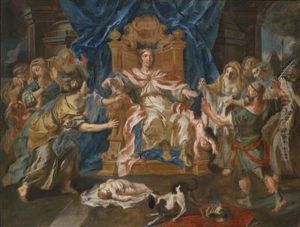Vincenzo Damini Paintings
Vincenzo Damini was an Italian painter, active during the Baroque period, born in 1688 in Venice, Italy. He is recognized for his contributions to the Venetian painting tradition, which was characterized by its vibrant color, emphasis on light, and dynamic compositions. Damini's work, while not as widely known as some of his contemporaries, represents an important link in the evolution of Venetian art from the Baroque to the Rococo style.
Damini initially trained under the guidance of Antonio Balestra, a prominent painter of the time, who played a significant role in shaping his early artistic development. This apprenticeship allowed Damini to hone his skills in drawing and painting, and to absorb the influences of the Venetian masters. Though much of his early work was influenced by his teacher, Damini gradually developed his own style, which combined the rich palette and luminous qualities typical of the Venetian school with a keen attention to detail and a slightly more restrained approach to composition.
Throughout his career, Damini worked on a variety of projects, including altarpieces, frescoes, and portraits. His religious works are particularly noted for their emotional intensity and for the skillful use of light to highlight the spiritual aspects of the scenes depicted. Damini's ability to convey the human condition, coupled with his mastery of color and light, made his religious paintings deeply moving to viewers.
Despite his talent and contributions to the Venetian art scene, Vincenzo Damini's work was somewhat overshadowed by the more dominant figures of his time, such as Giovanni Battista Tiepolo, with whom he is often compared. Nevertheless, his paintings are held in high regard by art historians and are considered key examples of the transition between Baroque and Rococo art in Venice.
Damini's legacy is preserved in several churches and public buildings in Venice and the surrounding region, where his frescoes and altarpieces can still be admired. He passed away in 1750, leaving behind a body of work that, while not as prolific as some of his peers, reflects the richness and diversity of 18th-century Venetian painting. Damini's contributions to the development of Venetian art are increasingly recognized and celebrated for their beauty, emotional depth, and technical proficiency.












